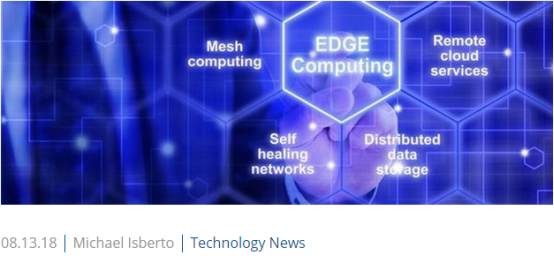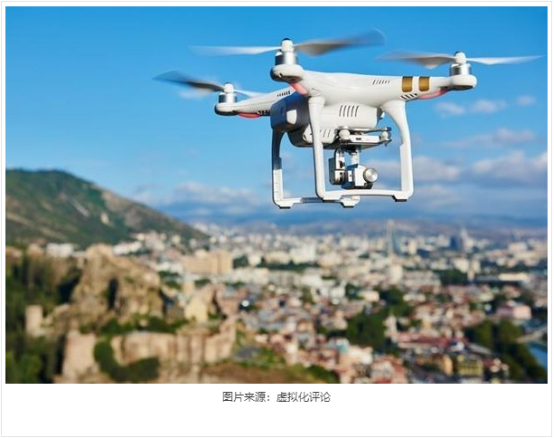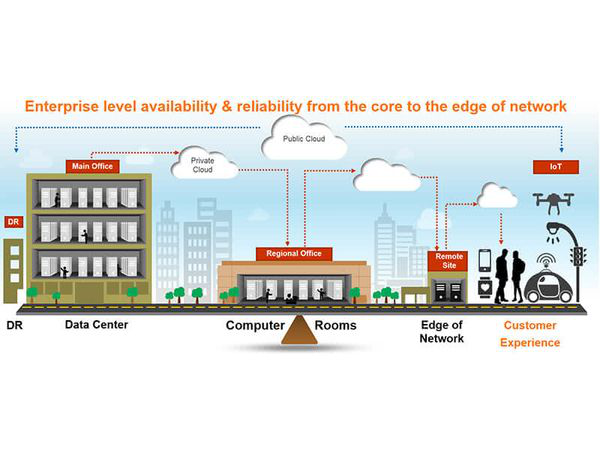How does the edge network relocate the data center?

Edge computing is one of the new buzzwords of technical terminology. This is what the "cloud" was originally conceived. In fact, there are some similarities between cloud computing and edge computing.
With the use of mobile devices, we will continue to retrieve data in cloud computing or edge computing. But since the cloud is a centralized, standalone platform, we often experience latency issues when dealing with dense data.
What is Edge Computing?
- Payment giant PayPal first involved in the blockchain investment and participated in the Cambridge Blockchain A round of financing
- OKEx CEO Jay Open Letter: The decision to launch Jumpstart is really tough
- FCoin trading mining anniversary: the pass economy is not going to work
Edge computing works by adding an additional platform between the user and the cloud so that some applications and data can be stored there without having to go through the cloud. The most important thing is that the location of this platform is physically closer to the user. This helps speed up processing because not all data comes directly from the cloud or device. It also speeds up the running of applications in user devices.

What is the difference between an edge network and a cloud network?
Some people think that edge computing will replace cloud computing. In fact, the two can work together. The collaboration between the two will reduce their respective pressures, while the two networks can reciprocate and benefit.
What is the difference between FOG Computing and edge calculation?
The processing power of edge calculations is closer to the data source and helps to process the data directly. Data does not need to be sent to the cloud or stored in any centralized system. Edge processing increases data transfer speed and overall performance by directly processing user data. It also improves the performance of devices that use edge computing.
Fog calculation is a term that is calculated before the edge. Many people think that fog calculation is the standard for edge calculation. However, edge computing transfers the processing power of the edge gateway directly to the device, while fog computing places processing power on the LAN and processes the data through the fog node or the IoT gateway.
The main difference between the two is where its processing power works. But because both fog calculations and edge calculations bring processing power closer to the user side, many people confuse it.

What are the edge calculation examples?
Drones, robots and driverless technology are becoming more common (well, at least the first two are like this). These devices can accumulate large amounts of data and use powerful data processing capabilities. They also have a need for low latency connections. These devices are excellent examples of edge computing.
Vapor IO and Hangar Technology have teamed up to create a prototype robot-powered world with an edge computing infrastructure. They plan to set up a drone base in the United States, the first base will be located in Chicago, Illinois.
Hangar Technology, Vapor IO and Project Volutus are expected to set up 40,000 wireless stations in the United States. They also plan to have 27 Kinetic Edge nodes by the end of 2018 and will add 100 nodes by 2019.
Just as electricity has to change its economic structure through a power supply network – automated robots also need a fully automated network to change infrastructure again. This project is a good example of how edge computing works in the real world, and it also shows us the possibility of future development.

What is an edge network? How will it reshape the data center?
According to a report by research firm IDC, 45% of the data created by the Internet of Things will be stored, processed and analyzed through edge computing. By 2020, more than 5 billion devices will be connected to the edge network. As a result, many companies will change the way they operate.
One of the industries that will undergo major changes is the data center industry. As far as we know, the data center will change due to the edge network. IDC researchers predict that the micro data center will be built into the existing tower network. These microdata centers process data in a manner similar to how current data centers manage information. Commercial customers can rent out their own space to support edge computing. In the future, we can make these small data centers closer to each enterprise, so that the delay problem becomes a past tense.
As we mentioned before, I am convinced that the advantages of these networks will not replace each other. Cloud, edge networks and data centers will each have a place in the data management arena. In fact, when they work together, the way we retrieve data will be faster and more powerful than before. This is crucial when integrating IoT systems.

Image source: Virtiv
What's the latest information on edge computing?
As the use of IoT devices increases, our demand for edge computing will also rise sharply. The concept of robot powered world and automated grid infrastructure is the latest and most exciting news in the field of edge computing. The grid will help many businesses and companies in real time. Although the concept is still in its early stages, the future is bright.
in conclusion
As technology advances, the network in which the device is currently located needs to be improved. This indicates that the edge network is inevitable as part of the future data management system. Because edge computing brings the network closer to the user and eliminates latency issues. It also helps reduce the data traffic of smart devices in IoT systems. Although people once thought that edge computing would replace cloud computing – they are more likely to work together to make our lives easier.
This article Source: First Class Warehouse is an information and information service company specializing in information collection, project analysis and project progress tracking of blockchain projects at home and abroad. It provides blockchain investors' due diligence for domestic and foreign blockchain investors. Analysis services.
Original source: https://www.colocationamerica.com/blog/edge-computing-changes-future-of->
Disclaimer: All articles on this site do not constitute investment advice or opinions. The market is risky and investment needs to be cautious. For reprint, please indicate the source.
We will continue to update Blocking; if you have any questions or suggestions, please contact us!
Was this article helpful?
93 out of 132 found this helpful
Related articles
- Explore the ant blockchain Open Day: We have seen the arrival of the blockchain commercial era!
- Bitcoin skyrocketing is a bullish signal, or is it a return light?
- Venture Capital Fund A16z has transformed: it will provide financial support for cryptocurrency startups up to $1 billion
- Market Analysis: BTC blows the bull market charge, but the most fierce is BCH
- VR, lottery, Internet of Things: the hot spot of the blockchain concept stock "Annie shares"
- Opinion: Bitcoin breaks $5,000, not a bull market but in a rational regression period
- Blockchain Policy March Report: Guangzhou Centralized Release Support Policy to Create Blockchain Industrial City?






